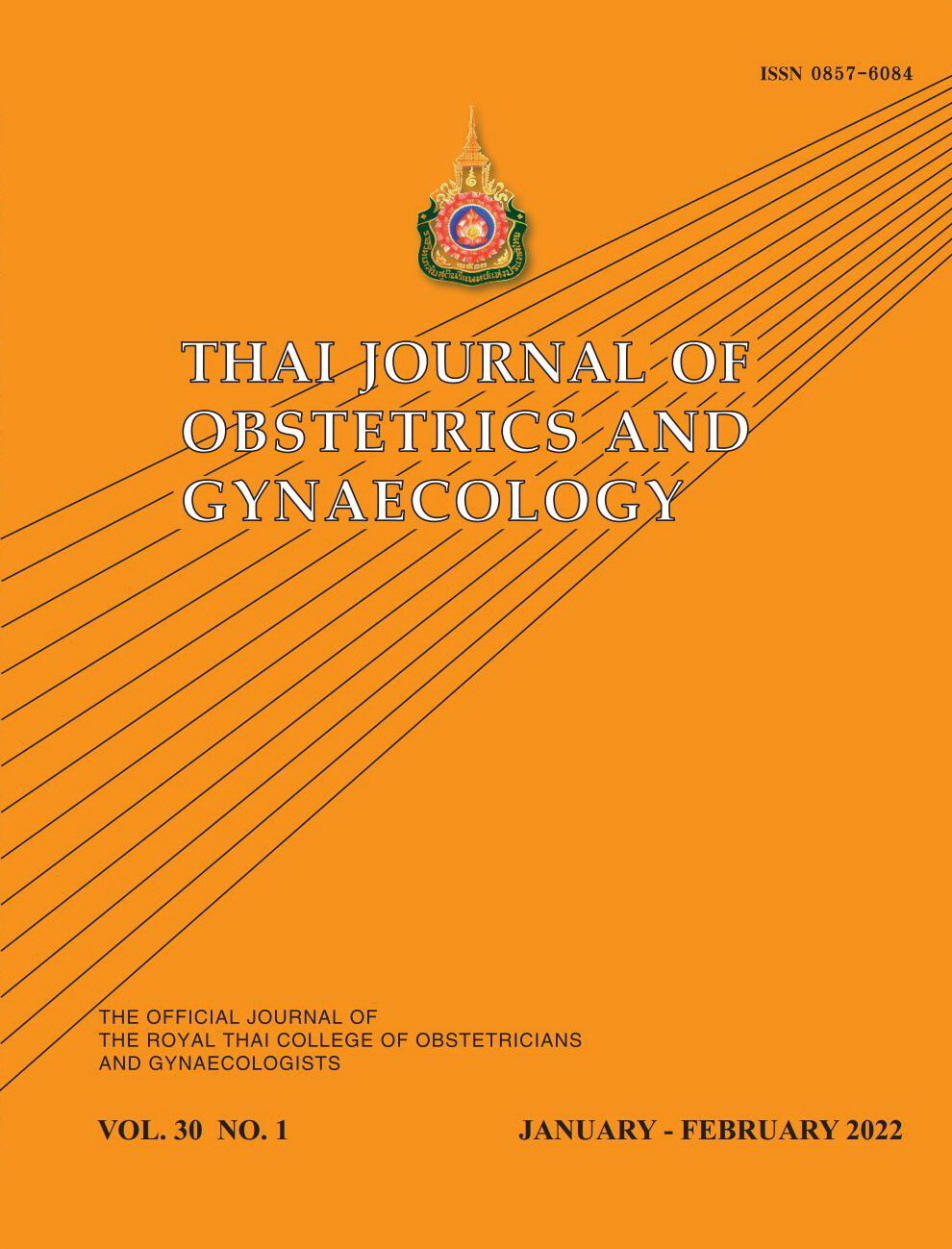Efficacy of Cold Gel Pack in Reducing Postoperative Pain in Cesarean Delivery at Sanpasitthiprasong Hospital: Randomized controlled trial
Main Article Content
Abstract
Objectives: To evaluate efficacy and safety of cold gel pack in adjunctive to standard pain control in reducing postoperative pain after Cesarean delivery
Materials and Methods: Between December 2019 and March 2020, 34 women who underwent Cesarean delivery under regional anesthesia with neuraxial opioid at Sanpasitthiprasong Hospital were recruited. They were randomized into two groups: 1) receiving adjunctive cold gel pack covering surgical wound at 2-hour postdelivery for 20 minutes (intervention group, n = 17) or 2) receiving standard pain control (control group, n = 17). Pain scores were assessed using visual analogue scale (VAS) at 2 hours (before intervention), 6 hours (4 hours after intervention) and 24 hours postdelivery. Data on additional analgesic drugs, possible complications, participant’s satisfaction were recorded. Pain scores were compared between treatment groups using student t-test and occurrence of complications compared using chi-square test.
Results: With comparable initial pain score, intervention group had significantly lower postoperative pain at 6 hours after Cesarean delivery than control group (mean pain score ± standard deviation 3.53 ± 2.12 and 5.44 ± 1.56 respectively, p = 0.005), but there was no difference at 24 hours postdelivery. Patients in both groups required similar amount of additional analgesia. There were no significant differences between groups in postpartum hemorrhage, length of hospital stays and surgical wound infection. There were moderate and high patient satisfaction similarly observed for the two groups. No adverse effect from intervention happened in the intervention group.
Conclusion: Adjunctive cold gel pack was efficacious in reducing postoperative pain at 6 hours after Cesarean delivery without safety concerns.
Article Details

This work is licensed under a Creative Commons Attribution-NonCommercial-NoDerivatives 4.0 International License.
References
Ramsay MAE. Acute postoperative pain management. Proc Bayl Univ Med Cent 2000;13:244-7.
Nadler SF, Weingand K, Kruse RJ. The physiologic basis and clinical applications of cryotherapy and thermotherapy for the pain practitioner. Pain Physician 2004;7:395-9.
Kılıc E, Ugur M. Effect of therapeutic hypothermia on superficial surgical site infection and postoperative pain in urgent abdominal surgery. Ulus Travma Acil Cerrahi Derg 2018;24:417-22.
Watkins AA, Johnson TV, Shrewsberry AB, Nourparvar P, Madni T, Watkins CJ, et al. Ice packs reduce postoperative midline incision pain and narcotic use: a randomized controlled trial. J Am Coll Surg 2014;219: 511-7.
Koc M, Tez M, Yoldas O, Dizen H, Gocman E. Cooling for the reduction of postoperative pain: prospective randomized study. Hernia 2006;10:184-6.
Nuangpho W, Srinil S, Tangsiriwatthana T, Sripipattanakul M. Gel pack reduced postoperative pain in benign gynecologic surgery: a randomized controlled trial. Thai J Obstet Gynaecol 2018;26:52-8.
Amin-Hanjani S, Corcoran J, Chatwani A. Cold therapy in the management of postoperative cesarean section pain. Am J Obstet Gynecol 1992;167:108-9.
Heller GZ, Manuguerra M, Chow R. How to analyze the visual analogue scale: Myths, truths, and clinical relevance. Scand J Pain 2016;13:67-75.
CDC. Surgical site infection (SSI) Event. Procedure-associated module [Internet]. 2020 [cited 2020 Sep 20];9-1-36. available from: http://www.cdc.gov/nhsn/pdfs/pscmanual/9pscssicurrent.pdf
Janmanee T, Yusamran C, Ratinthorm, Phahuwatanakorn W. Effects of cooling and heat application on perineal inflammation and pain in postpartum. J Nurs Sci 2014; 32:25-34.
Hanprasertpong T, Kor-anantakul O, Prasartwanakit V, Leetanaporn R, Suntharasaj T, Suwanrath C. Efficacy of cryoanalgesia in decreasing pain during second trimester genetic amniocentesis: a randomized trial. Arch Gynecol Obstet 2012;286:563-6.
Kanazi GE, Aouad MT, Abdallah FW, Khatib MI, Adham AMBF, Harfoush DW, et al. The analgesic efficacy of subarachnoid morphine in comparison with ultrasound-guided transversus abdominis plane block after cesarean delivery: a randomized controlled trial. Anesth Analg 2010;111: 475-81.
Ravindhran B, Rajan S, Balachandran G, Mohan LN. Do ice packs reduce postoperative midline incision pain, NSAIDS or narcotic use? World J Surg 2009;43:2651-7.
Chumkam A, Pongrojpaw D, Chanthasenanont A, Pattaraarchachai J, Bhamarapravatana K, Suwannarurk K. Cryotherapy reduced postoperative pain in gynecologic surgery: a randomized controlled trial. Pain Res Treat 2019;2019:1-6.
Campos GO, Martins MJ, Jesus GN, Rios PR, Lessa CN, Fernandes JCM, et al. Palonosetron versus ondansetron for prevention of nausea and vomiting after total abdominal hysterectomy under spinal anesthesia with intrathecal morphine: a double-blind, randomized controlled trial. BMC Anesthesiology 2019;19:159.
Weston M, Taber C, Casagranda L, Cornwall M. Changes in local blood volume during cold gel pack application to traumatized ankles. JOSPT 1994;19:197-9.
Masuzawa Y, Kataoka Y, Nakamura S, Yaju Y. Cooling the lower abdomen to reduce postpartum blood loss: A randomized controlled trial. PLoS ONE 2017;12: e0186365.
Kennet J, Hardaker N, Hobbs S, Selfe J. Cooling Efficiency of 4 Common Cryotherapeutic Agents. J Athl Train 2007;42:343-8.
Rivlin M, King M, Kruse R, Ilyas AM. Frostbite in an Adolescent Football Player: A Case Report. J Athl Train 2014;49:97-101.


